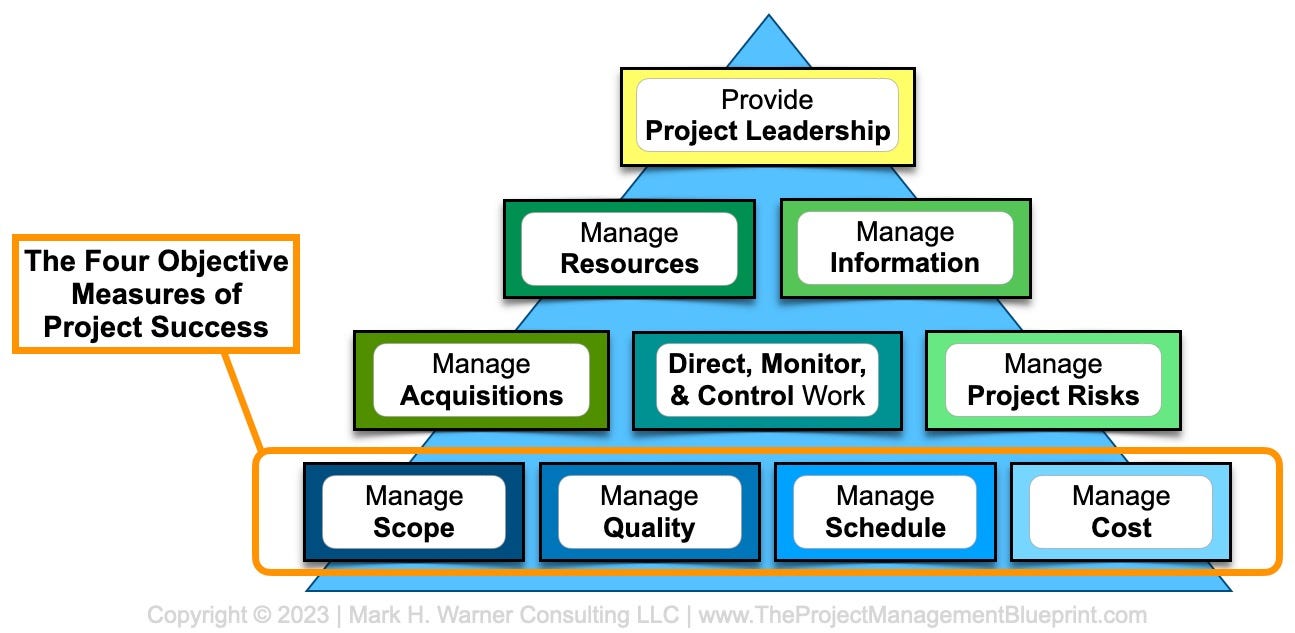Objective Measures of Project Success
Focusing on Scope and the triple constraints of Quality, Schedule, and Cost
At the base of the Project Manager’s Pyramid, underpinning and supporting all other PM responsibilities are the management of Scope, Quality, Schedule, and Cost. These four fundamental criteria of every project are the most quantitative in nature, objective, easily measured, and important metrics of project success.
At the end of a project, you should be able to determine whether each of these was accomplished or not. And if they were not, you can/should be able to determine exactly how far off the mark you were.
1. Product Scope
Scope is what the project is fundamentally about creating. It is what the project team and you developed and delivered and handed-over at the end of the project. Success is therefore primarily determined by whether you delivered the product scope to the customer or not.
As project manager, your goal is to create and deliver 100% of the scope, as defined in the Product Breakdown Structure (PBS). The PBS is a subset of the overall Work Breakdown Structure (WBS), and it defines and lists exactly what the deliverables are that the Project was asked to design, create, test, and deliver to the customer or end user.
Scope success is measured literally by looking at the PBS and verifying that each element has been completed or not.
2. Acceptance Quality
In simple terms, quality is the predetermined measure of how “good” the delivered Scope is. On most engineering projects, Quality is typically measured in several common areas, such as form, fit, function, performance, interfaces, and a variety of other things, like adherence to standards & codes, safety requirements, etc.
On most engineering projects, we measure quality directly against these types of predetermined requirements and specifications. This is done at all levels of the project, including components, subsystems, assemblies, and the overall system.
Results from these tests are typically documented in test reports and summarized, ultimately, in compliance matrices, in which all requirements are listed and verified, usually with links to test procedures used, data collected during testing, and test reports. Deviations from any requirements are noted and typically subject to approval by the project’s change control board (CCB) via formal relief documents called Requests for Waiver, or RFWs.
3. Schedule
A project schedule is the planned timeline in which the work is to be accomplished. It defines the overall time constraints placed on the project, including key milestone dates for measuring progress and, ultimately, the handover of the product scope to the customer or end user.
The determination of whether a project was successful or not is determined by whether these key milestone dates, including the final project completion date constraints, were achieved or not. And if they weren’t, how far behind schedule were they accomplished?
Schedule performance during a project is measured in a variety of ways, including tracking milestones, measuring percentage-complete of activities, and, more frequently, via formal variances that arise from Earned Value Management (EVM) calculations.
4. Cost
The fourth and final objective measure of project success is whether the project was completed within the original total project cost cap or not.
Like schedules, a project budget is a relatively straightforward and definable metric of success. While executing a project, we typically look at things like spending curves, contingency burn rates, and EVM cost variances. At the end of the project, the ultimate criteria for measuring cost success is simply the difference between the final cost actuals and the approved budget.
The Bottom Line:
At the start of a project, and for each of the four objective measures of project success (Scope, Quality, Schedule, and Budget), we need to predetermine what success should look like. We cannot plan for, nor achieve success until these four elements are fully defined, documented, and baselined (approved) before executing the project. It is essentially impossible for us to hit a target if we don’t know what the target is.
As project managers, we should ensure that each of the four elements have clearly defined success criteria and predefined (and approved) measurement methods. Simply saying, for example, that the project needs to “be on time” isn’t enough. What exactly does “on time” mean, and how will it be measured and verified?
As you progress through managing your project, we should focus the team’s primary efforts on delivering and adhering to the four project definition/baseline elements. We must plan our projects—first—around delivering the Product Scope to the stakeholders within the constraints of Quality, Schedule, and Budget.


